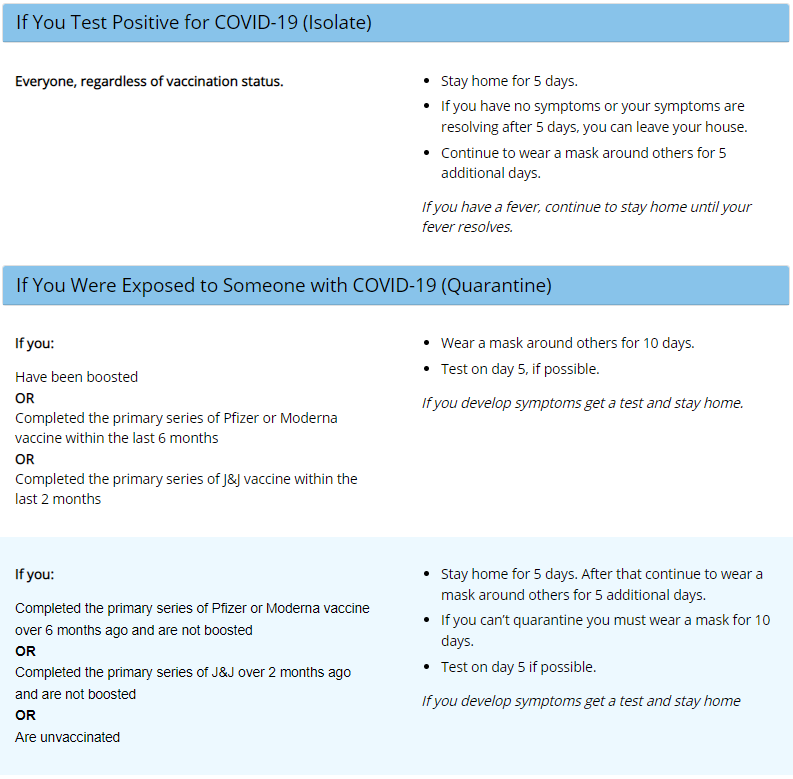A New Year Rings in New COVID-19 Rules for Employers and More Uncertainty
Much has developed during the holiday season. Courts moved back and forth on various vaccine mandates, the federal government halted implementation of vaccine deadlines or pushed them back, the CDC changed the isolation and quarantine period, the EEOC provided new guidance on “long COVID” and COVID-19 complications, and rumors circulated that the DOL will issue guidance on wage and hour issues related to COVID-19 testing. This Alert serves to help employers track these changes in a time of legal uncertainty.
CDC Shortens Isolation and Quarantine Periods
On December 27, 2021, amidst surging cases of the Omicron variant, the CDC announced changes to the isolation and quarantine time periods. The changes are premised on the CDC’s contention that the majority of COVID-19 transmission occurs in the 1-2 days prior to onset of symptoms and the 2-3 days after. As such, those with COVID-19, regardless of vaccine status, should isolate for five days (rather than the previous 10-day period). Similarly, those who have been exposed to COVID-19 should quarantine for five days, unless they are fully vaccinated. However, if a five-day quarantine is not feasible, an exposed person should wear a well-fitting mask, such as an N95, at all times when around others for 10 days after exposure. The CDC also recommends a COVID-19 test five days after exposure.
Below is the most recent CDC chart that provides additional detail:

Facing criticism for the shortened time periods, the CDC considered adding a negative test to five-day isolation period for people with asymptomatic infections. Yesterday, the CDC announced that while it would not formally recommend a negative COVID-19 test for a person to leave isolation, a rapid antigen test at the end of the isolation period is best. It also released a media statement recommending a booster for those with the Pfizer vaccine after 5 months, which may implicitly change the full vaccination status for those who had the Pfizer vaccine. To be considered fully vaccinated with the Pfizer vaccine, an individual arguably must have either have been boosted or completed the primary series within the last 5 months (not 6 months as the above chart indicates).
Employers in Michigan that are subject to the COVID-19 Employment Rights Act (CERA) should follow the above chart when determining when an employee may return to work following an exposure or positive case. However, because of the legal complexities and industry-specific exemptions of CERA, employers should consult counsel when faced with workplace COVID-19 isolation/quarantine issues.
OSHA ETS Vaccine Mandate for Large Employers
On January 7, the United States Supreme Court will hear oral argument to determine if OSHA’s ETS Vaccine Mandate is enforceable.
Given the recent reversal of the Fifth Circuit’s injunction, OSHA has updated its timelines for enforcement. Subject to a change from the Supreme Court, the current schedule is as follows:
By January 10, 2022, employers should:
- Track employee vaccination status
- Create a database detailing vaccination information for each employee
- Require unvaccinated employees to wear a mask
- Provide paid time off for employees to get vaccinated and recover
Starting February 9, 2022, employers must:
- Require unvaccinated employees to test for Covid-19 weekly. Both antigen (rapid tests) and PCR tests are permitted. But the employee cannot both self-administer and self-read the test. Examples of permitted tests include the following:
- Drive-thru rapid test at a pharmacy in which the test (commonly a nasal swab) is self-administered and the results are read by the pharmacy;
- On-site or virtual test proctored by the employer in which the employer observes the employee perform the self-test and observes the test indicate the result;
Employers should also gather the required notices relating to the Mandate to roll out to employees.
- COVID-19 Vaccination and Testing ETS
- “Key Things to Know About COVID-19 Vaccines” (CDC)
- Workers’ Rights under the COVID-19 Vaccination and Testing ETS
- Information for Employees on Penalties for False Statements and Record
Centers for Medicare and Medicaid Services (CMS) Vaccine Mandate for Healthcare
In a recent Client Alert, Butzel summarized the status of the CMS vaccine mandate based on recent court decisions that left the CMS mandate in effect for healthcare employers in approximately half the country—including Michigan.
As summarized in Butzel's most recent Healthcare Alert, the Supreme Court has agreed to hear oral arguments on the CMS Mandate on January 7—the same day it will hear arguments regarding the OSHA ETS Vaccine Mandate.
In another recent development, CMS has updated its guidance indicating that it will begin enforcing the vaccine mandate in the District of Columbia, U.S. Territories, as well as California, Colorado, Connecticut, Delaware, Florida, Hawaii, Illinois, Maine, Maryland, Massachusetts, Michigan, Minnesota, Nevada, New Jersey, New Mexico, New York, North Carolina, Oregon, Pennsylvania, Rhode Island, Tennessee, Vermont, Virginia, Washington and Wisconsin.
CMS has, however, pushed back the compliance dates for the mandate in the above states and territories. Healthcare employers in these jurisdictions are subject to the following requirements:
By January 27, 2022, employers ensure that staff at all health care facilities included within the regulation must have received the first dose of a COVID-19 vaccine (or the single dose Johnson & Johnson vaccine) prior to that staff person providing any patient care, treatment, or other services within the covered facility. (Phase 1).
By February 28, 2022, employers must require all staff to have received their second dose of a COVID-19 vaccine. (Phase 2).
Federal Contractor Vaccine Mandate
Following a nationwide injunction issued by a Georgia Federal Court, the Federal Contractor Vaccine Mandate (EO 14042) is not in effect. The various lawsuits, including the case in Georgia, in which preliminary injunctions were granted will now proceed to the next stage in which a decision for a permanent injunction is made on the merits based on a fully developed record. Meanwhile, the federal government is seeking to reverse these orders. Other federal courts are also considering similar requests for injunctions against EO 14042 enforcement.
EEOC’s Updated Guidance on COVID-19 Disabilities
On December 14, 2021, the EEOC issued new guidance relating to when COVID-19 is a qualifying disability under the ADA and Rehabilitation Act. It specifically dealt with “long COVID” and the circumstances under which COVID-19 related health complications may qualify as a disability. For more detail see Butzel’s recent Client Alert.
As always, Butzel is here to answer any questions you have about employee COVID-19 related issues. Please contact your Butzel Labor and Employment Attorney.
Brett Miller
313.225.5316
millerbr@butzel.com
Sarah Nirenberg
248.258.2919
nirenberg@butzel.com












